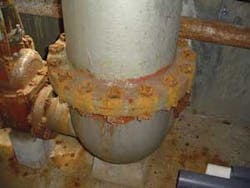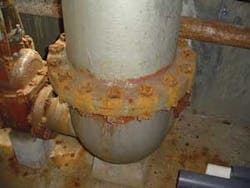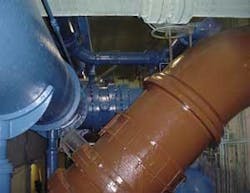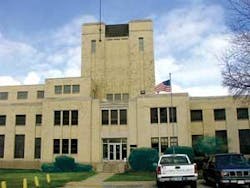Moisture-Cured Coatings Tackle Conditions Inside Water Plant
Polyurethane coating technology is often chosen for demanding exterior applications such as bridges, stadiums and other large structures. But when maintenance was required inside the Hammond Water Filtration Plant in Hammond, IN, a moisture-cured polyurethane system proved to be the only way to go to coat more than 35,000 square feet of piping and valves.
The plant, which was built in 1936 and renovated in 1950 and 1970, posed numerous repainting challenges. Some of the pipes had never been coated, producing major corrosion problems. There were no records for the surfaces that had been coated, but it was likely that lead was present. Naturally, it was imperative to remove the rust and any lead-based paint before any recoating took place. In addition, very cold water being piped into the plant caused significant condensation, making coating difficult. There was no chance of shutting down or taking any of the pipes out of service since the plant filtered 70 millions gallons of water per day.
In October 2004, Hammond called upon Dixon Engineering of Lake Odessa, MI, to evaluate the project and make recommendations.
“Performance and aesthetics were the major considerations – they wanted the job to last and look good 15-20 years from now,” said Dixon Vice President, Ira Gabin. “The crew would be limited to working in winter months when pipe sweating is minimal. In late spring and summer, you’d get huge differentials in water temperature, and it would be like walking through a waterfall in there.”
Dixon Engineering specified a moisture-cured urethane (MCU) system formulated from raw materials manufactured by Bayer MaterialScience. They called on Sherwin-Williams, who agreed to deliver the paint within a week’s time. The Sherwin-Williams system consisted of two different Corothane primers to be used on two different types of pipes, plus an intermediate coat of Corothane I IronOx B, and a Corothane I aliphatic topcoat.
Given the conditions inside the plant, Gabin noted that “The MCU system opened a bigger painting window for us.”
Specifications were sent to 17 paint contractors, and 14 came to the site for a mandatory pre-bid walk-through. Everyone needed to know the extent of the project – and the complications they would be facing. Eight companies submitted a bid. In January 2005, Era Valdivia from Chicago was awarded the job.
“We walked this plant twice just to make sure we were comfortable with the logistical challenges. The bottom line was going to be proper planning and execution,” said Project Manager Greg Bairaktaris.
Work was scheduled to be completed in two phases so that the painting contractor could work in the cooler months. Era Valdivia began Phase I in March 2005. Access to certain areas was difficult, to say the least. There were only two entrances to the plant, and work needed to be done upstairs and downstairs. The painting crew had to carefully stage their hoses and other equipment around the plant staff’s work area. Plant Superintendent Gary Williams admits he was nervous about protecting valves, controls, and other vulnerable equipment. If any parts were damaged, he would have operations problems – and major expense.
Bairaktaris notes that the surface preparation was particularly challenging. Dehumidification was necessary to remove condensation from the pipes in order to hold the blast. If dehumidification was not used, flash rusting would have occurred.
The substrate was mostly steel, which needed to be blasted to SP10 specification before it was coated with Corothane I GalvaPak. Cast iron pipes were prepped to SP6, then coated with Corothane I MIO Zinc. The moisture-cured Corothane system actually compensated for some of the on-site problems because it could be applied if the pipes were damp, and could handle some flash rusting.
“It was hard to get the surface clean enough and moisture-free,” Bairaktaris said. “You couldn’t get that cast iron to near-white. But the moisture-cured system solves problems on the engineering side, as well as on the application side.”
Once the primer was applied, the Corothane intermediate and topcoats followed. Since all the pipes needed to be color-coded, the topcoats were made with six different pigments. And because the Corothane I aliphatic topcoat emitted a low (3.5) VOC, the plant could remain in operation even during the final stages of the maintenance project.
“It was a difficult application,” Bairaktaris said. “We needed to use a combination of brush, roller and spraying techniques. We’d spray the piping system first, then cut around it for the color-coded piping. It wasn’t a straightforward job.”
Era Valdivia completed one room at a time during Phase I before tackling Phase II in January 2006. Both phases were completed on time, with minimal disruption to normal plant operations – and with minimal damage to vulnerable equipment. In all, the project spanned two years and required 900 gallons of coating.
Circle No. 216 on Reader Service Card



